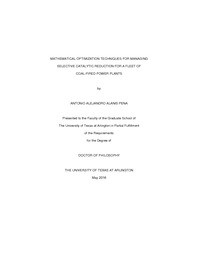| dc.description.abstract | Major commercial electricity generation is done by burning fossil fuels out of which coal-fired power plants produce a substantial quantity of electricity worldwide. The United States has large reserves of coal, and it is cheaply available, making it a good choice for the generation of electricity on a large scale. However, one major problem associated with using coal for combustion is that it produces a group of pollutants known as nitrogen oxides (NOx). NOx are strong oxidizers and contribute to ozone formation and respiratory illness. The Environmental Protection Agency (EPA) regulates the quantity of NOx emitted to the atmosphere in the United States. One technique coal-fired power plants use to reduce NOx emissions is Selective Catalytic Reduction (SCR). SCR uses layers of catalyst that need to be added or changed to maintain the required performance. Power plants do add or change catalyst layers during temporary shutdowns, but it is expensive. However, many companies do not have only one power plant, but instead they can have a fleet of coal-fired power plants. A fleet of power plants can use EPA cap and trade programs to have an outlet NOx emission below the allowances for the fleet. For that reason, the main aim of this research is to develop an SCR management mathematical optimization methods that, with a given set of scheduled outages for a fleet of power plants, minimizes the total cost of the entire fleet of power plants and also maintain outlet NOx below the desired target for the entire fleet.
We use a multi commodity network flow problem (MCFP) that creates edges that represent all the SCR catalyst layers for each plant. This MCFP is relaxed because it does not consider average daily NOx constraint, and it is solved by a binary integer program. After that, we add the average daily NOx constraint to the model with a schedule elimination constraint (MCFPwSEC). The MCFPwSEC eliminates, one by one, the solutions that do not satisfy the average daily NOx constraint and the worst NH3 slip until it finds the solution that satisfies that requirement. We introduce an algorithm called heuristic MCFPwSEC (HMCFPwSEC). When HMCFPwSEC algorithm starts, we calculate the cost of the edges estimating the average NH3 slip level, but after we have a schedule that satisfies the average daily NOx constraint and the worst NH3 slip, we update the cost of the edges with the average NH3 slip for this schedule. We repeat this process until we have the solution. Because HMCFPwSEC does not guarantee optimality, we compare its results with SGO, which is optimal, using computational experiments. The results between both models are very similar, the only important difference is the time to solve each model. Then, a fleet HMCFPwSEC (FHMCFPwSEC) uses HMCFPwSEC to create the SCR management plan for each plant of the fleet, with a discrete NOx emissions value for each plant. FHMCFPwSEC repeats this process with different discrete levels of NOx emissions, for each plant, in order to create a new problem with schedules with different cost and NOx emissions for each plant of the fleet. Finally, FHMCFPwSEC solves this new problem with a binary integer program, in order to satisfy a NOx emission value for the fleet that also minimizes the total cost for the fleet, and using each plant once. FHMCFPwSEC can work with single cut and also with multi-cut methods. Because FHMCFPwSEC does not guarantee optimality, we compare its results with fleet SGO (FSGO) using computational experiments. The results between both models are very similar, the only important difference is the time to solve each model. In the experiments, FHMCFPwSEC multi-cut targeting new layer always uses less time than FSGO. | |


